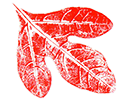Coralberry (Symphoricarpos orbiculatus) is a deciduous shrub that is native to most of the eastern half of the U.S. It typically grows 2-4 feet tall and is most commonly found in semi-open woods. Coralberry blooms during the summer, but the flowers are not very showy and are often overlooked. It produces pinkish to purplish berries that will stay on the shrub even after the leaves fall off. The berries tend to be much more visible than the flowers.

Coralberry is an important plant for pollinators and wildlife. Many different bee species will visit the flowers, and it considered an important plant for honey bees in Kentucky. Several species of pollinating wasps and flies will also use the flowers. The foliage is eaten by the caterpillars of two species of clearwing or hummingbird moths. Deer will also heavily browse the foliage. In the fall and winter, robins and other songbirds, as well as, many small mammals will eat the fruit. Coralberry can also form dense hedges that provide valuable shelter for many species of wildlife including songbirds.
For those wanting to plant coralberries, they can be difficult to start from seed and require both a warm and a cold period before they will germinate. Your best bet for successfully planting coralberry in your landscape is to find a rooted plant for sale. The native coralberry (seeds and plants) can sometimes be found in native plant nurseries. Several cultivars have also been developed and are available through the horticulture industry.

This article was part of Shannon’s original Kentucky Pollinators and Backyard Wildlife blog which evolved into the blog for Backyard Ecology.

Backyard Ecology: Exploring Nature in Your Backyard
Nature isn’t just “out there.” It’s all around us, including right outside our doors. Hi, my name is Shannon Trimboli, and I am the host of Backyard Ecology. I live in southcentral Kentucky and am a wildlife biologist, educator, author, beekeeper, and owner of a nursery specializing in plants for pollinators and wildlife conservation. I invite you to join me as we ignite our curiosity and natural wonder, explore our yards and communities, and improve our local pollinator and wildlife habitat. Learn more or subscribe to my email list at www.backyardecology.net.

Leave a Reply